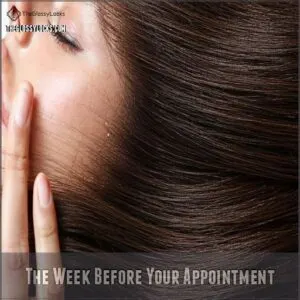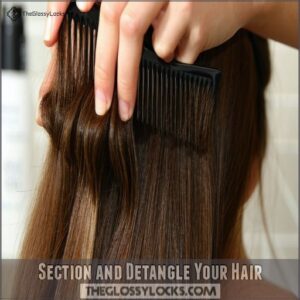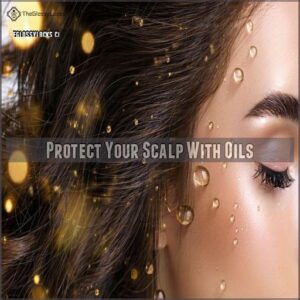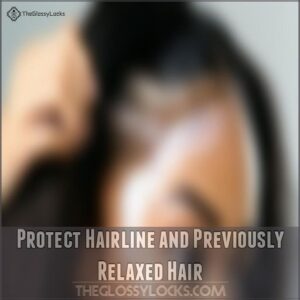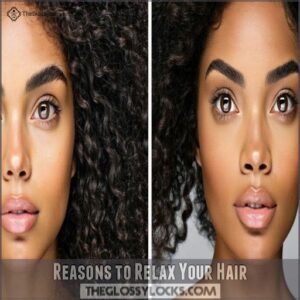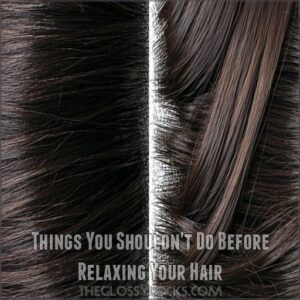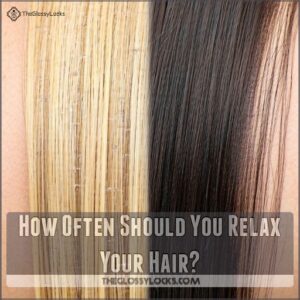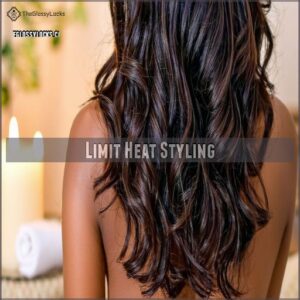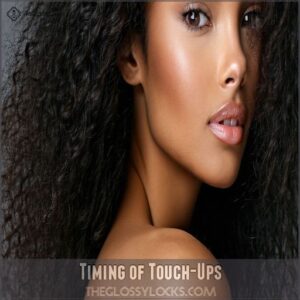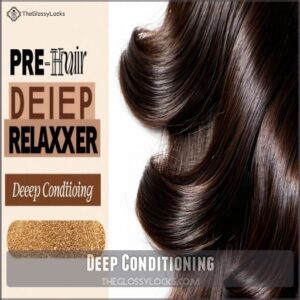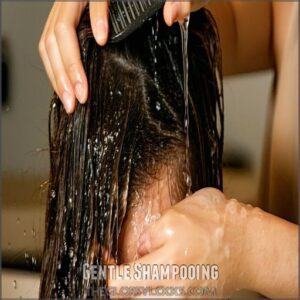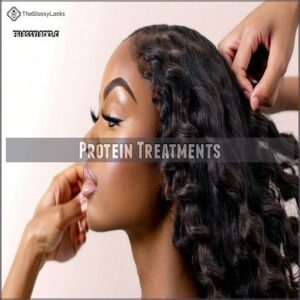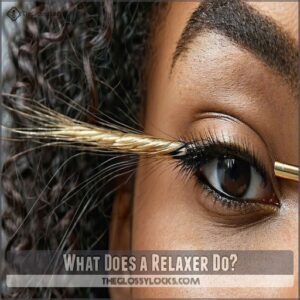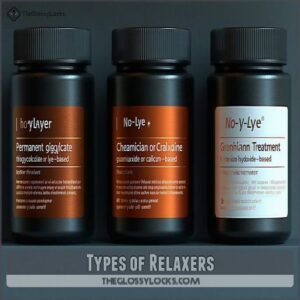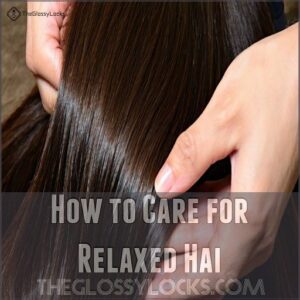This site is supported by our readers. We may earn a commission, at no cost to you, if you purchase through links.
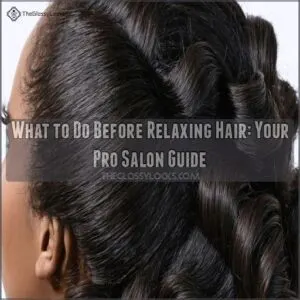 Before relaxing your hair, you’ll want to prep like a pro.
Before relaxing your hair, you’ll want to prep like a pro.
Start a week ahead by deep conditioning with protein treatments to strengthen your strands.
Avoid washing your scalp and skip harsh chemical processes. Gently detangle your hair and section it carefully.
On appointment day, protect your scalp and hairline with oils like coconut or jojoba, and apply a thick barrier cream around delicate edges.
Skip chemical dyes and strenuous activities that might irritate your scalp.
Your hair’s about to get a transformation, and proper preparation is your secret weapon for smooth, manageable locks that’ll turn heads and boost your confidence.
Table Of Contents
- Key Takeaways
- The Week Before Your Appointment
- The Day Of; Before You Go to Your Appointment
- Reasons to Relax Your Hair
- Things You Shouldn’t Do Before Relaxing Your Hair
- How Often Should You Relax Your Hair?
- Maintaining Your Hair Between Treatments
- What Does a Relaxer Do?
- Types of Relaxers
- How to Care for Relaxed Hai
- Frequently Asked Questions (FAQs)
- What should I do if my hair is relaxed?
- What are the ways to take care of hair?
- When should you relax your hair?
- Can you relax your own hair?
- How do you Relax Your Hair before a relaxer appointment?
- How do I maintain healthy hair when using a relaxer?
- What is the Difference Between a Relaxer and a Texturizer?
- How Long Does a Relaxer Last?
- What Are the Side Effects of a Relaxer?
- Can I Relax My Hair if I Have Color-treated Hair?
- Conclusion
Key Takeaways
- You’ll want to deep-condition your hair with protein treatments a week before your relaxer to strengthen your strands and minimize potential damage.
- Don’t wash your scalp or engage in harsh chemical processes in the week leading up to your appointment; instead, gently detangle your hair and protect your scalp with natural oils like coconut or jojoba.
- Carefully section your hair into 4+ symmetrical parts and apply a thick barrier cream around your hairline and delicate edges to prevent chemical irritation during the relaxing process.
- You’ll need to avoid chemical dyes, intense workouts, and activities that cause excessive sweating in the days before your relaxer to ensure your hair and scalp are in the best possible condition for the treatment.
The Week Before Your Appointment
As your relaxer appointment approaches, you’ll want to prepare your hair with strategic care and attention.
Prioritize deep conditioning.
Avoid scalp irritation.
Focus on sealing in moisture to guarantee your hair is in its best possible condition for the upcoming treatment.
Deep Conditioning With Protein Packed Wash and Conditioner
Seven days before your relaxer, transform your hair’s destiny with a protein-packed conditioning ritual.
Here’s your game plan:
- Choose a strengthening protein treatment
- Target dry, brittle ends
- Opt for keratin-rich products
- Saturate hair from roots to tips
- Lock in moisture like a pro
Avoid Scalp Irritation
Your scalp’s sensitivity demands strategic pre-relaxer care. Here’s how to dodge irritation and keep your crown happy:
- Skip scalp washing and scratching for one week before your appointment.
- Steer clear of sweating, heat styling, and harsh chemical treatments.
Seal in Moisture
Shield your locks from potential damage by lavishing them with deep conditioning treatments, lightweight oils, and protective pre-relaxer hydration masks that’ll keep your hair singing smooth, soft melodies.
To maximize the benefits, consider implementing a moisture sealing technique to lock in existing moisture and prevent further drying.
- Deep condition with protein-packed masks
- Coat strands with protective natural oils
- Minimize heat styling to preserve moisture balance
The Day Of; Before You Go to Your Appointment
Before heading to your relaxer appointment, take time to properly prepare your hair and protect your delicate scalp from potential irritation.
Gently section and detangle your locks.
Apply protective oils.
Create a barrier around your hairline to facilitate a smooth, professional treatment that keeps your hair healthy and beautiful.
Section and Detangle Your Hair
Ready to transform your locks? Mastering hair sectioning is your ticket to a flawless relaxer.
Grab a wide-tooth comb and get strategic with your approach:
- Divide hair into 4+ symmetrical sections
- Start at the roots, gently detangle each segment
- Work methodically from scalp to ends
- Move slowly to minimize potential breakage
Protect Your Scalp With Oils
A battle shield for your scalp starts with the right oils before your relaxer appointment.
Coconut, olive, and jojoba oils are your secret weapons for pre-relaxer scalp protection.
Gently massage these liquid guardians into your scalp, working through each section with care and precision.
Don’t rush—let the oils penetrate for at least 30 minutes, creating a protective barrier that’ll keep your skin calm and resilient.
This simple step isn’t just preparation; it’s your first line of defense against potential irritation during the relaxing process.
Protect Hairline and Previously Relaxed Hair
After protecting your scalp with oils, focus on safeguarding your hairline and previously relaxed hair.
Here’s your game plan:
- Apply a thick base cream around edges
- Use petroleum jelly as a protective barrier
- Create clean, precise hair sections
- Prevent chemical overlap on processed areas
- Block potential damage before relaxing
Reasons to Relax Your Hair
If you’re tired of spending hours battling frizz and struggling with unmanageable hair, a professional hair relaxer might be your ultimate styling solution.
You’ll love how relaxers transform your locks, giving you smoother, shinier hair that’s easier to style and requires less daily maintenance.
Low Maintenance
Because time is precious, relaxed hair offers you the ultimate time-saving style.
Imagine cutting your morning routine in half with easy upkeep and effortless looks that require minimal styling products.
Your hair transforms into a low-maintenance dream that keeps you looking fresh and confident.
Less Frizz, More Shine
Reveal shiny, frizz-free hair with a relaxer that transforms your locks.
Experience the magic of smooth, manageable styles that give you total hair confidence.
- Bye-bye unruly frizz
- Hello sleek perfection
- Instant hair liberation
- Smooth styles all day
- Confidence in every strand
Potential for Less Damage
A relaxer can be your hair’s secret weapon to minimize breakage and prevent damage.
By choosing gentle products and understanding pre-relaxer treatments, you’ll transform unruly locks into smooth, manageable strands.
smooth, manageable strands that radiate health and confidence.
Things You Shouldn’t Do Before Relaxing Your Hair
Before treating your hair with a relaxer, you’ll want to steer clear of certain activities that could compromise your hair’s health and the effectiveness of the treatment.
By avoiding chemical dyes, excessive sweating, and scalp irritation,
you’ll set the stage for a smoother, more successful relaxer application that keeps your locks looking their best.
Avoid Chemical Dyes
Your hair deserves a fresh start before relaxing.
Chemical dyes can wreak havoc on your hair’s delicate structure, setting you up for potential disaster during the relaxer process.
Consider using a pre relaxer hair treatment product, like those found in pre relaxer hair treatments, to help prepare your hair.
Steer clear of these color risks:
- Permanent dyes that compromise hair integrity
- Harsh bleaching treatments
- Home color kits
- Experimental color experiments
Avoid Strenuous Activities
With pre-relaxer fitness in mind, steering clear of strenuous activities guarantees your hair’s health and relaxer success.
Harsh chemical treatments like chemical relaxers can weaken hair, making it more prone to breakage if not properly cared for.
- Skip intense workouts
- Minimize sweating
- Rest and recover before appointment
How Often Should You Relax Your Hair?
Managing the relaxer frequency can feel like walking a tightrope between styling goals and hair health. Determining how often you should relax your hair depends on several key factors that’ll make or break your hair’s overall well-being.
To minimize damage, choosing the right shampoos for relaxed hair is vital in helping restore moisture and balance.
10 Key Factors Influencing Relaxer Frequency:
- Natural hair texture‘s resilience
- Current hair damage level
- Scalp sensitivity
- Personal styling preferences
- Hair growth speed
- Previous chemical treatments
- Lifestyle and activity levels
- Moisture retention capacity
- Professional stylist recommendations
- Individual hair strength
Your relaxer hair routine isn’t one-size-fits-all. Fine-haired beauties may need touch-ups every 8-10 weeks, while those with thicker locks could stretch to 12-16 weeks.
The golden rule? Listen to your hair. Watch for signs of over-processing, breakage, or excessive dryness. A professional stylist can help you strike the perfect balance between maintaining your desired style and protecting your hair’s health, ensuring your relaxed locks stay stunning and strong.
Maintaining Your Hair Between Treatments
You’ll need a solid strategy to keep your relaxed hair looking fabulous between salon visits.
By focusing on gentle care, deep conditioning, and smart maintenance, you’ll preserve your hair’s health and extend the life of your gorgeous new style.
Limit Heat Styling
Anyone battling heat damage can break free from styling struggles by embracing smart choices that protect their relaxer-bound locks.
- Use heat protectants religiously before any styling
- Embrace air-drying as your hair’s best friend
- Experiment with no-heat styling techniques
- Invest in silk or satin pillowcases for gentler hair treatment
Timing of Touch-Ups
To minimize damage and prevent overlapping, choosing the right relaxer for your hair type is vital, especially for specific needs like those for 4c hair.
Your relaxer touch-up frequency depends on your hair’s growth rate, aiming for 6-8 weeks to prevent overlapping and minimize damage.
Deep Conditioning
Deep conditioning transforms relaxed hair from fragile to fierce. Here’s your game plan:
- Choose protein-rich deep conditioners
- Apply weekly or bi-weekly
- Use heat for maximum absorption
- Target damaged ends first
Gentle Shampooing
After conditioning your locks, keep them pristine with sulfate-free shampoo.
Gently cleanse every 3-4 days, using lukewarm water and a wide-toothed comb to maintain your relaxed hair’s health and shine.
| Cleansing Tip | Frequency | Impact |
|---|---|---|
| Sulfate-free | 3-4 days | Protects Hair |
| Lukewarm H2O | Gentle | Prevents Damage |
| Wide-tooth Comb | Post-wash | Minimizes Breakage |
Protein Treatments
Want stronger, healthier relaxed hair? Protein treatments are your secret weapon for hair resilience:
- Rebuild hair’s internal structure
- Prevent breakage before relaxing
- Restore essential hair protein
What Does a Relaxer Do?
Hair transformation begins with a relaxer – your personal magic wand for reshaping those stubborn curls.
It’s more than just a styling trick; it’s a chemical revolution that breaks down your hair’s natural bond structure. When you apply a relaxer, you’re basically giving your locks a new identity, permanently altering the curl pattern to create smoother, more manageable strands.
The process works by penetrating the hair shaft, disrupting the protein bonds that create your natural texture. This isn’t just straightening – it’s a complete hair makeover that promises sleeker, easier-to-style tresses.
But remember, with great power comes great responsibility: the chemical process requires careful application and ongoing maintenance to keep your newly liberated hair looking its best.
Types of Relaxers
Mastering the art of silky-smooth locks begins with selecting the right relaxer for your hair’s unique personality.
Before making a decision, consider exploring the different best relaxer types to find the perfect fit.
Explore three powerhouse options that’ll revolutionize your styling game:
Permanent Chemical Relaxers
- Break free from curl constraints with thioglycolate or lye-based formulas that rewrite your hair’s natural blueprint.
No-lye relaxers offer a gentler alternative, wielding guanidine or calcium hydroxide to straighten without the intensity of traditional lye treatments.
Keratin treatments sneak in as the smooth operator, infusing your strands with protein to tame frizz and make them more manageable.
Pro tip: Your stylist is your hair’s best ally in guiding you through these chemical crossroads, helping you choose a relaxer that speaks directly to your hair’s specific needs.
How to Care for Relaxed Hai
Once you’ve chosen your relaxer type, maintaining those smooth locks becomes your new mission. Regular deep conditioning, such as every 2 weeks for healthy hair, can help strengthen hair and reduce breakage as seen in deep conditioning methods.
Protect your investment with these pro tips:
- Limit heat styling to prevent unnecessary damage
- Deep condition weekly for maximum hair health
- Use sulfate-free products to maintain your relaxer’s magic
Treat your hair like the crown it’s – with love, care, and strategic maintenance.
Frequently Asked Questions (FAQs)
What should I do if my hair is relaxed?
You’ve tamed your wild mane, now what?
Maintain your relaxed locks by deep conditioning weekly.
Use sulfate-free shampoo and moisturize daily.
Space touch-ups every 8-10 weeks to keep your hair healthy and stunning.
What are the ways to take care of hair?
Nourish your relaxed locks with sulfate-free shampoo, daily leave-in conditioner, and minimal heat styling.
Deep condition regularly, use protein treatments, and space out touch-ups.
Maintain healthy, vibrant hair that shines with confidence. Healthy, vibrant hair is the goal.
When should you relax your hair?
Worried about hair damage?
Relax your hair when new growth reaches 1-2 inches, typically every 8-10 weeks.
Listen to your hair’s needs, avoid overlapping, and consult a professional stylist for personalized advice on timing and technique.
Can you relax your own hair?
While possible, relaxing your own hair involves high risks.
Professional stylists recommend expert application to prevent damage.
expert application also guarantees even coverage and protects your scalp from potential chemical burns or uneven processing.
How do you Relax Your Hair before a relaxer appointment?
Like a canvas prepped for a masterpiece, your hair needs careful attention before relaxing.
Gently detangle.
Avoid shampooing for a week.
Protect your scalp with oil.
Let a professional guide you through this transformative hair journey.
How do I maintain healthy hair when using a relaxer?
Maintain your relaxed hair’s health by deep conditioning regularly, using sulfate-free products, and limiting heat styling.
Space out touch-ups.
Moisturize daily, and protect your locks with protein treatments to keep them strong and vibrant. relaxed hair’s health strong and vibrant.
What is the Difference Between a Relaxer and a Texturizer?
Just as a tailor transforms a basic garment, a relaxer completely straightens your hair, while a texturizer softens your curl pattern, giving you less dramatic change and more natural-looking definition.
How Long Does a Relaxer Last?
A relaxer typically lasts 6-8 weeks before new growth appears.
You’ll want to touch up roots carefully.
Avoiding overlapping to prevent damage and maintain your sleek, smooth hair’s health and appearance.
What Are the Side Effects of a Relaxer?
Chemical relaxers can cause scalp burns, hair breakage, and potential allergic reactions.
You might experience dryness, thinning hair, and increased sensitivity.
Proper application and aftercare can minimize these risks and help maintain your hair’s health.
Can I Relax My Hair if I Have Color-treated Hair?
You’ll want to consult a professional stylist before relaxing color-treated hair.
The process requires extra caution to prevent damage.
as the chemical treatments can weaken your hair’s structure and increase the risk of breakage. This is especially important for color-treated hair.
Conclusion
Ultimately, prepping for what to do before relaxing hair isn’t just about a salon visit—it’s about protecting your hair’s health and beauty.
By following these pro tips, you’ll transform your hair care routine and minimize potential damage.
Remember, relaxing isn’t just a treatment; it’s an investment in your hair’s future.
Stay patient, gentle, and proactive, and you’ll rock stunning, smooth locks that reflect your personal style and confidence. Stunning, smooth locks are the result of proactive hair care.

